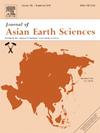上扬子上奥陶统大渡河组碳同位素与古环境变化
IF 2.7
3区 地球科学
Q2 GEOSCIENCES, MULTIDISCIPLINARY
引用次数: 0
摘要
晚奥陶世是地球历史上发生重大变化的一个时期,在此期间显生宙的第一次大灭绝事件发生在奥陶世末。虽然大量的研究都集中在这一事件上,但很少有研究对灭绝前的生物环境变化进行研究。本研究以上扬子地区上奥陶统大渡河组为研究对象,该组主要由碳酸盐岩和黑色页岩混合组成,为末奥陶统大灭绝前的一套沉积序列。对云南东北部万河地区上奥陶统大渡河组的δ13Ccarb和δ13Corg数据进行了分析。其中,云南东北万河组δ13Ccarb(- 2.62‰~ 2.27‰VPDB,平均值0.12‰)和δ13Corg(- 30.75‰~ - 26.17‰VPDB,平均值- 29.62‰)记录显示,大渡河组下段碳同位素偏移为正。大渡河组的碳同位素正偏移与北美和欧洲等效地层中的PAROVEJA事件相当,这是有机埋藏增强的结果。我们假设,由于气候变暖和陆地养分流入海洋的增加,大陆风化作用增强,促进了有机生产/埋藏。这导致δ13Ccarb正偏移,同时导致水柱脱氧和碳酸盐工厂的破坏。本文章由计算机程序翻译,如有差异,请以英文原文为准。
Carbon isotopic and paleoenvironmental changes recorded in the Upper Ordovician Daduhe Formation, Upper Yangtze, China
The Late Ordovician was a time interval witnessing significant changes in Earth’s history during which the first mass extinction event of the Phanerozoic occurred in the end-Ordovician. While extensive research has focused on this event, fewer studies have examined the bio-environmental changes in the pre-extinction interval. Here, we investigate the Upper Ordovician Daduhe Formation, composed mainly of mixed carbonates and black shales in the Upper Yangtze region, which is a succession deposited before the end-Ordovician mass extinction. Both δ13Ccarb and δ13Corg datasets were analyzed in the Upper Ordovician Daduhe Formation from Wanhe, northeastern Yunnan Province. Of these, paired δ13Ccarb (−2.62 ‰ to 2.27 ‰ VPDB, avg. 0.12 ‰) and δ13Corg (−30.75 ‰ to − 26.17 ‰ VPDB, avg. − 29.62 ‰) records from Wanhe (northeastern Yunnan) reveal a positive carbon isotope excursion in the lower member of the Daduhe Formation. This positive carbon isotope excursion in the Daduhe Formation is comparable to that, namely the PAROVEJA event, in the equivalent strata in North America and Europe, as a result of enhanced organic burial. We hypothesize that enhanced continental weathering due to climate warming and enhanced terrestrial nutrient fluxes into the ocean, promote organic production/burial. This drives positive δ13Ccarb excursion while simultaneously leading to de-oxygenation of the water column and the destruction of the carbonate factory.
求助全文
通过发布文献求助,成功后即可免费获取论文全文。
去求助
来源期刊

Journal of Asian Earth Sciences
地学-地球科学综合
CiteScore
5.90
自引率
10.00%
发文量
324
审稿时长
71 days
期刊介绍:
Journal of Asian Earth Sciences has an open access mirror journal Journal of Asian Earth Sciences: X, sharing the same aims and scope, editorial team, submission system and rigorous peer review.
The Journal of Asian Earth Sciences is an international interdisciplinary journal devoted to all aspects of research related to the solid Earth Sciences of Asia. The Journal publishes high quality, peer-reviewed scientific papers on the regional geology, tectonics, geochemistry and geophysics of Asia. It will be devoted primarily to research papers but short communications relating to new developments of broad interest, reviews and book reviews will also be included. Papers must have international appeal and should present work of more than local significance.
The scope includes deep processes of the Asian continent and its adjacent oceans; seismology and earthquakes; orogeny, magmatism, metamorphism and volcanism; growth, deformation and destruction of the Asian crust; crust-mantle interaction; evolution of life (early life, biostratigraphy, biogeography and mass-extinction); fluids, fluxes and reservoirs of mineral and energy resources; surface processes (weathering, erosion, transport and deposition of sediments) and resulting geomorphology; and the response of the Earth to global climate change as viewed within the Asian continent and surrounding oceans.
 求助内容:
求助内容: 应助结果提醒方式:
应助结果提醒方式:


